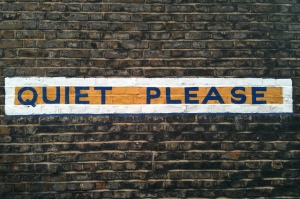So, I’ve been thinking about the impact that restraints have on writing. This was a topic on one of the days of the teaching writing workshop I attended and loved over the summer. The two creative writing teachers shared a number of ideas from their classes.
The idea is that having some constraints around the writing is in fact helpful for getting going. They particularly suggested setting as something to consider making a constraint. So, the class might brainstorm a list of possible settings and then each student would write a brief piece set in one of the times and places. Try considering this yourself. If you are told the story takes place on a bus or in a local chain restaurant or at the library, there are probably ideas that come to your mind right away.
This past semester one of my goals for my English class was to do some creative writing. We did talk about the setting exercise and played with the idea in class. Then, what I ended up doing was asking students to find a sentence in the book we had just finished and use it in their creative writing. (I wrote earlier about my other goal for this project, which was to find an audience for this work. That part did not end up being super successful. More on that later.) However, providing the constraint of the sentence by our expert author was successful. Some students took a sentence and also borrowed a similar general genre. Sentences from Slaughterhouse-Five ended up in new stories about people returning from war. However, others took it as a deliberate challenge to do exactly the opposite with the sentence. What? Students setting a challenging goal for themselves and then following through? Victory.
I did not write a story with a sentence, although I should have. I have continued to work on blackout poetry, which I have written about numerous times on its own and in conjunction with my personal taxonomy projects. Most recently I tried using catalog text, which did not lead to such great work. I have been thinking about moving to the sports section of the newspaper as my starting block. Like my student who wanted to turn the sentence he found on its head, I wanted to take on the constraint of articles from the sports section and erase all sports from the resulting poems. Although I had started this a few times, I finally got to it on our snow day. Sports themed blackout poetry taxonomy project here I come. Thank you Jonas the blizzard.
I took the Sunday Sports section of the January 24th New York Times and started with the front page articles. I was lucky in that there were a few not so sporty articles. As I got going, I realized that the article was continued on an inside page, as were all the articles. So, I decided to add another constraint to my poetry–all the poems from the front page portion of the article had to end with the word continued (or continue).
I found that having that end goal gave direction to some of my other word picking. I find it easy to be distracted by a choice word when I am trying to write one of these poems. (I have the same trouble at a buffet. One thing grabs my attention and then the next thing you know I have a plate full of random items that do not go together in any way other than they are yummy.) Since I do need to have something leap out at me or force me to make a first choice, it’s in some ways handy to have a word jump out at me. The problem is that sometimes that first sparkly word should just be the catalyst and nothing more (catalysts do not actually get mixed in with the chemical reactions. They get things going, but stay apart. So interesting.) Anyway, some of the first words that catch my eye or ear should not really be involved at all in the final poem. But knowing that I had at least one word all set was sort of comforting.
Here are the three first poems.
Poem 1
Untitled
A car shop on Friday afternoon
He leaned on the counter and smacked the bell several times
He claims to have arrived that day
He figures that some version of his sales pitch can continue.
Poem 2
“Danger May Lurk”
Take Pause,
They meet to decide to do
Something they rarely do
It is continued.
Poem 3
“Most Unlikely”
The man did not mind
The talk about lucky charm that seemed to grow
Like virulent kitchen mold.
There is the matter of finances;
The spending continued.
Then, I decided that I would go to the continuation of each article and make another poem from the rest of the article. No continued in this poem and the point was to have the poem be different. I also tried to have words from all columns, even though the poems are meant to be read left to right instead of up and down, and to have some words towards the end so that the poem got all the way, or most of the way, down the page. This seemed important to me visually; I’m not sure why. Another constraint.
First second part
“At Least in Winter”
From the front room you can probably see
Posters from the movie.
I’m thinking why would you do that?
For about the next 15 years
He does good work–great work,
Cradling the phone
Flashing a peace sign.
Second second part
“Favorites, Take Pause”
At this time of year
You just get accustomed to this trouble spot.
In late November love
Was a lot different
To play.
Final second part
“Most Improbable”
The story routinely
Almost exclusively
And undeniable
Took place at the final buzzer
In Charlotte four years ago.
He would never forget
That there was more.
So, there you have it. I claim neither to have written award-winning poetry nor to have students who wrote prize-winning stories. However, we all created. We all made these little bits of things with words within the constraints, which turned out not to constrain us at all.


